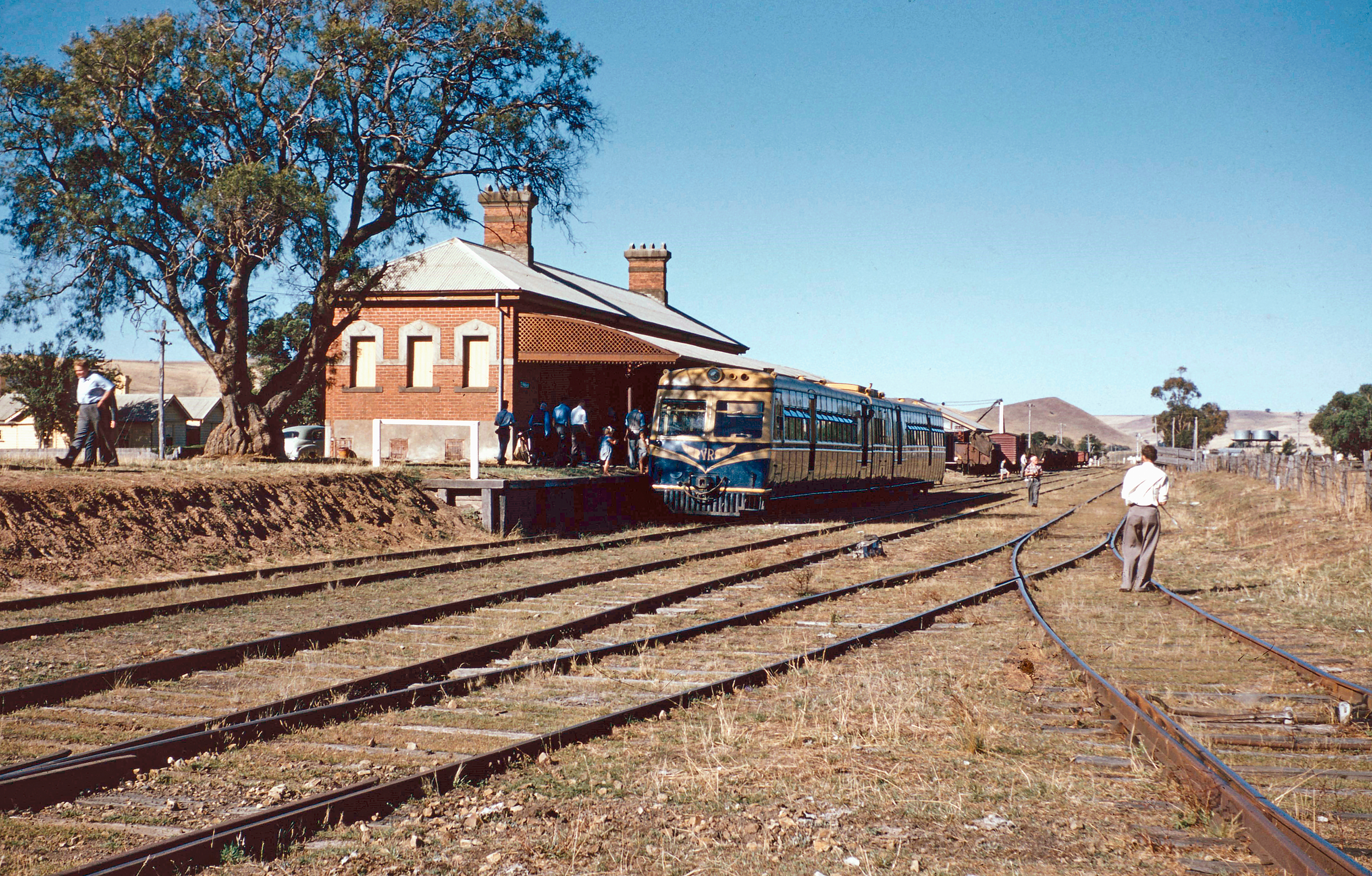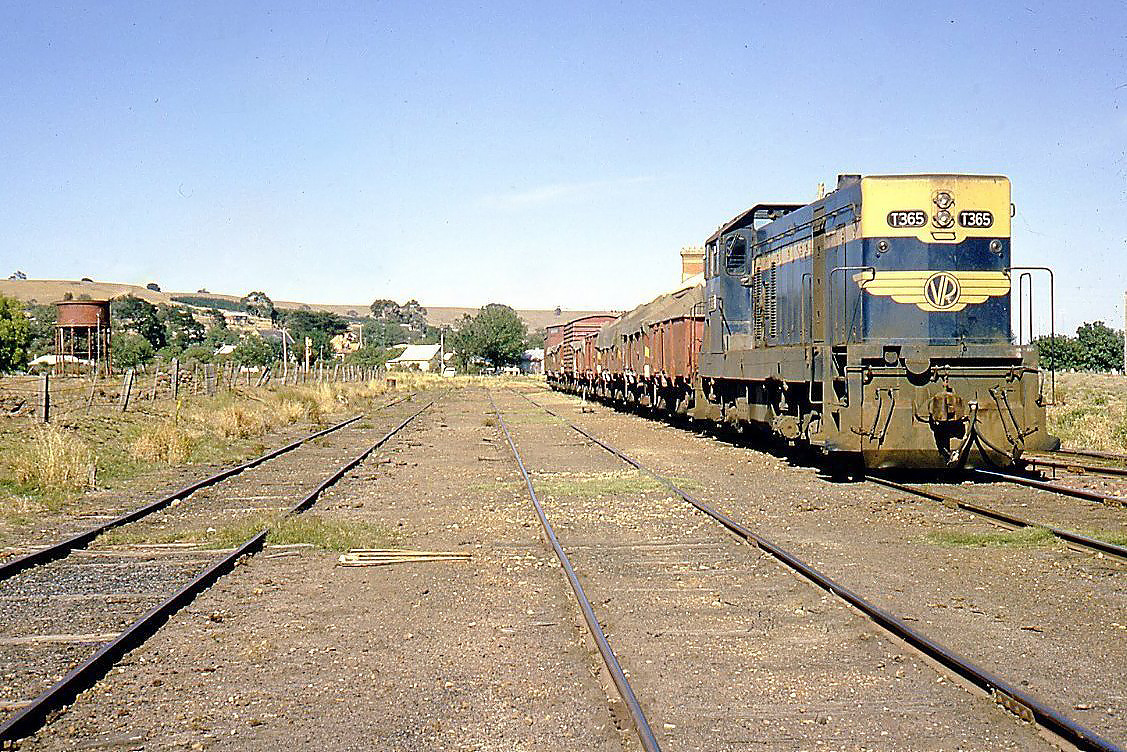Coleraine line.
The 23 mile long Coleraine line branched off the Ararat to Portland line at Coleraine Junction which was just south of Hamilton. It opened on Nov 20 1888. Passenger service was withdrawn on Aug 12 1952 and the entire line was closed Sep 12 1977. Livestock represented a major source of traffic. For the year ending June 1950, Coleraine dispatched 453 wagons of sheep and 306 wagons of cattle as well as 842 passengers.



ABOVE: A busy morning at Coleraine as the morning train prepares for departure, the second vehicle appears to be a W workmens sleeper which appeared in 1910 so this photo dates from around 1915 - 1920 I believe. R 315 was built 1884, off reg 1927. (photo from State Library of Victoria collection) BELOW: The same view in Nov. 2011.


ABOVE: Coleriane station building, possibly circa 1920, photo courtesy SLV.

ABOVE: The proud staff and happy customers at Coleraine pose in front of an AEC railmotor. As shown in the 1928 timetable below, this was a daily service that departed Coleraine at 11.10 am. It took 1 hour and 40 minutes to travel the 24 miles to Hamilton where you would change to a loco hauled passenger train to Ararat, where you would change again for your train to Melbourne, the total journey time to Melbourne being being 10 hours and 35 minutes. But what a journey it would be! Circa 1928. Coleraine lost its passenger service on Aug 12 1952.



ABOVE: A 280 Walker sits at Coleraine platform whilst running a railfan special, Feb 23 1957, photo courtesy Des Jowett.

ABOVE: Much of the original 234 feet long platform at Coleraine has been cut back at the down end to facilitate the loading of goods wagons. (photo courtesy Neville Gee)

ABOVE: This elevated April 1976 view over Coleraine station and yard shows the general run down condition of the railway some eighteen months prior to closure of the line. The area below the water tank has now been turned into parkland and includes a lake. (photo courtesy Neville Gee)

ABOVE: A street side view of the station on 12 March 1963. Try and identify all the various model of Holden vehicles. (photo courtesy Neville Gee)

ABOVE: On 23 June 1971 prior to entering regular service on the Ararat to Portland line, new Tulloch DRC 40 ran a promotional trip to both Coleraine and Casterton. Despite appalling weather on the day there were large crowds at each of these termini. (photo courtesy Neville Gee)

ABOVE: This view shows the loading ramp and the reason for the platform being cut back. as well as people queuing out of the rain to get on board the DRC. (photo courtesy Neville Gee)

ABOVE: Several short return shuttle trips were run along the line so people could sample the smooth and comfortable ride these cars were noted for. The DRC is seen here approaching Coleraine on one such shuttle. (photo courtesy Neville Gee)

ABOVE: Second series T Class, T 365 stands at the head of its train ready to depart Coleraine on 2 January 1968. (photo courtesy Neville Gee)

ABOVE: Just beyond the site of Parkwood station (renamed in 1930 from Gritjurk) there is a lengthy section with 1 in 40 gradients and several 30 chain curves. This is from the highest elevation on the line with the rail motor seen here coasting down this section towards the terminus. (photo courtesy Neville Gee)
Wannon

ABOVE: Aerial view of Wannon circa 1930.

ABOVE: In October 1970 Wannon was the only intermediate station on the Coleraine line with any sort of building remaining. (photo courtesy Neville Gee)

ABOVE: Pleasant undulating countryside is evident here as 56 DERM passes over the Wannon River bridge prior to arriving at the Wannon station. The river is much smaller here than where it is crossed further downstream by the Casterton railway line. 17 October 1970. (photo courtesy Neville Gee)
Bochara

ABOVE & BELOW: Looks like the track gang have their work cut out for them with this major derailment at McKinnons creek (about one mile on the down side of Bochara) on Sep 7 1910.



ABOVE: 56 DERM running an AREA tour to Coleraine is crossing the Grange Burn Creek trestle bridge. The town of Hamilton is seen in the background. 17 October 1970. (photo courtesy Neville Gee)




